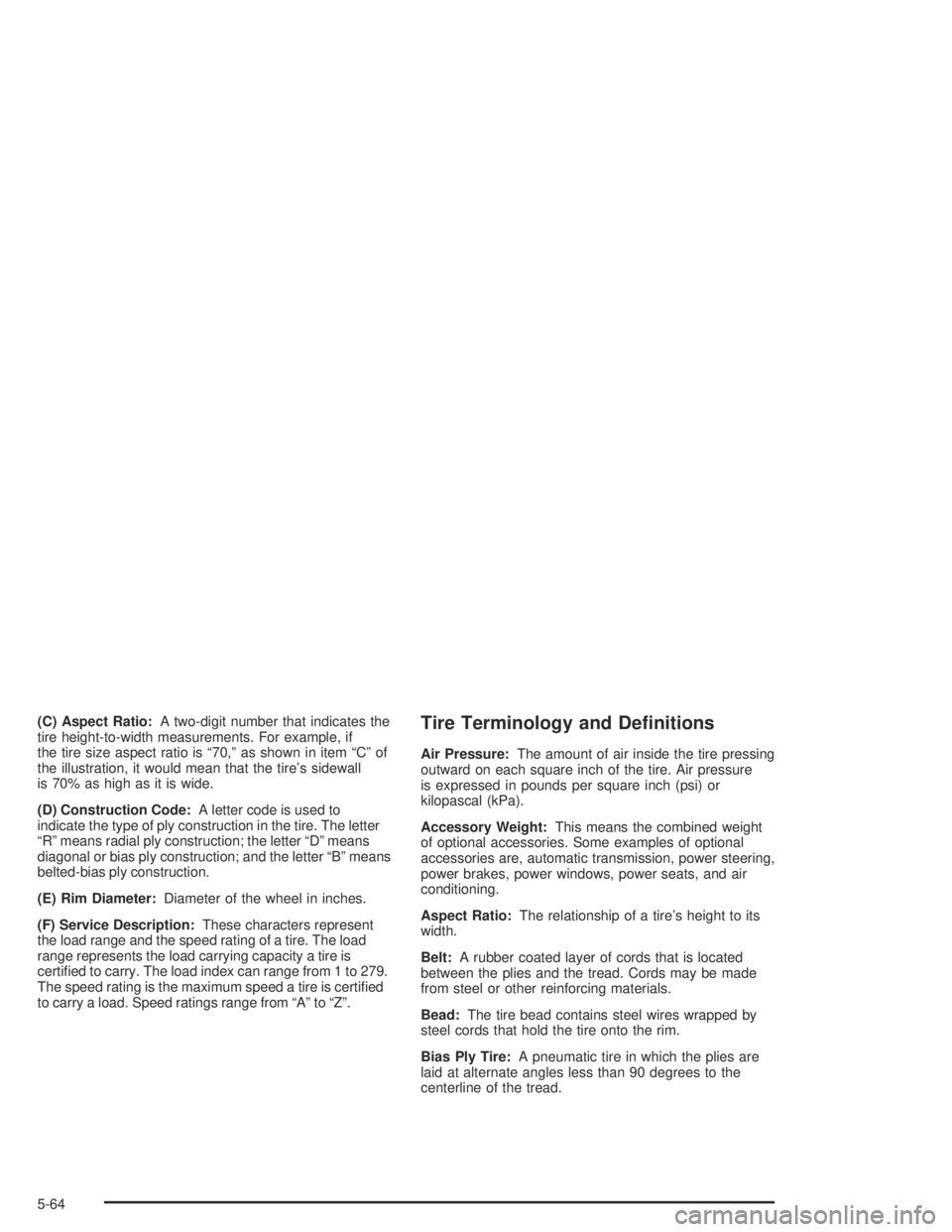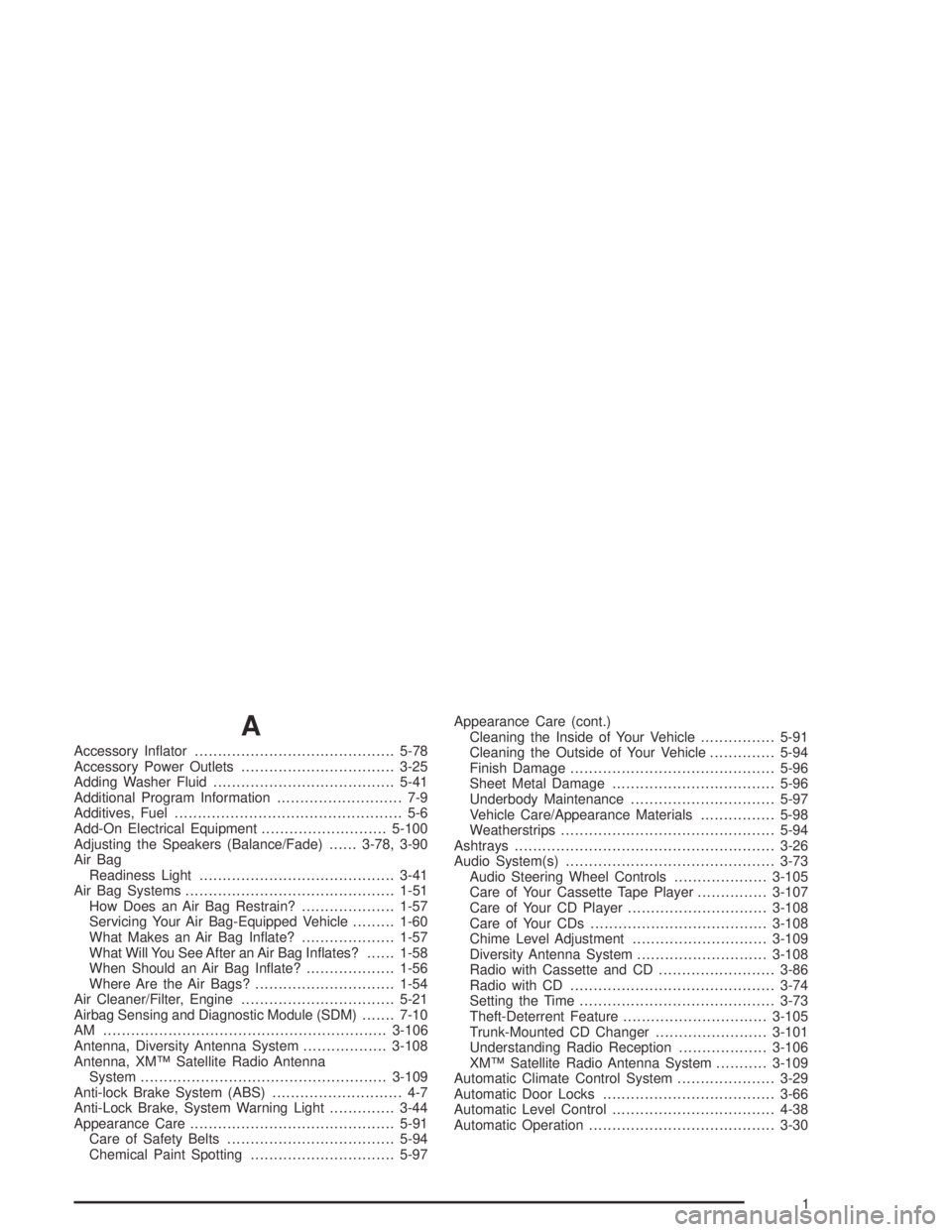2004 PONTIAC BONNEVILLE steering wheel
[x] Cancel search: steering wheelPage 340 of 446

(C) Aspect Ratio:A two-digit number that indicates the
tire height-to-width measurements. For example, if
the tire size aspect ratio is “70,” as shown in item “C” of
the illustration, it would mean that the tire’s sidewall
is 70% as high as it is wide.
(D) Construction Code:A letter code is used to
indicate the type of ply construction in the tire. The letter
“R” means radial ply construction; the letter “D” means
diagonal or bias ply construction; and the letter “B” means
belted-bias ply construction.
(E) Rim Diameter:Diameter of the wheel in inches.
(F) Service Description:These characters represent
the load range and the speed rating of a tire. The load
range represents the load carrying capacity a tire is
certi�ed to carry. The load index can range from 1 to 279.
The speed rating is the maximum speed a tire is certi�ed
to carry a load. Speed ratings range from “A” to “Z”.Tire Terminology and De�nitions
Air Pressure:The amount of air inside the tire pressing
outward on each square inch of the tire. Air pressure
is expressed in pounds per square inch (psi) or
kilopascal (kPa).
Accessory Weight:This means the combined weight
of optional accessories. Some examples of optional
accessories are, automatic transmission, power steering,
power brakes, power windows, power seats, and air
conditioning.
Aspect Ratio:The relationship of a tire’s height to its
width.
Belt:A rubber coated layer of cords that is located
between the plies and the tread. Cords may be made
from steel or other reinforcing materials.
Bead:The tire bead contains steel wires wrapped by
steel cords that hold the tire onto the rim.
Bias Ply Tire:A pneumatic tire in which the plies are
laid at alternate angles less than 90 degrees to the
centerline of the tread.
5-64
Page 355 of 446

If a Tire Goes Flat
It’s unusual for a tire to “blowout” while you’re driving,
especially if you maintain your tires properly. If air goes
out of a tire, it’s much more likely to leak out slowly.
But if you should ever have a “blowout,” here are a few
tips about what to expect and what to do:
If a front tire fails, the �at tire will create a drag that
pulls the vehicle toward that side. Take your foot off the
accelerator pedal and grip the steering wheel �rmly.
Steer to maintain lane position, and then gently brake to
a stop well out of the traffic lane.
A rear blowout, particularly on a curve, acts much like a
skid and may require the same correction you’d use
in a skid. In any rear blowout, remove your foot from the
accelerator pedal. Get the vehicle under control by
steering the way you want the vehicle to go. It may be
very bumpy and noisy, but you can still steer. Gently
brake to a stop, well off the road if possible.{CAUTION:
Lifting a vehicle and getting under it to do
maintenance or repairs is dangerous without
the appropriate safety equipment and training.
The jack provided with your vehicle is
designed only for changing a �at tire. If it is
used for anything else, you or others could be
badly injured or killed if the vehicle slips off
the jack. Use the jack provided with your
vehicle only for changing a �at tire.
If a tire goes �at, the next part shows how to use your
jacking equipment to change a �at tire safely.
5-79
Page 431 of 446

A
Accessory In�ator...........................................5-78
Accessory Power Outlets.................................3-25
Adding Washer Fluid.......................................5-41
Additional Program Information........................... 7-9
Additives, Fuel................................................. 5-6
Add-On Electrical Equipment...........................5-100
Adjusting the Speakers (Balance/Fade)......3-78, 3-90
Air Bag
Readiness Light..........................................3-41
Air Bag Systems.............................................1-51
How Does an Air Bag Restrain?....................1-57
Servicing Your Air Bag-Equipped Vehicle.........1-60
What Makes an Air Bag In�ate?....................1-57
What Will You See After an Air Bag In�ates?......1-58
When Should an Air Bag In�ate?...................1-56
Where Are the Air Bags?..............................1-54
Air Cleaner/Filter, Engine.................................5-21
Airbag Sensing and Diagnostic Module (SDM).......7-10
AM .............................................................3-106
Antenna, Diversity Antenna System..................3-108
Antenna, XM™ Satellite Radio Antenna
System.....................................................3-109
Anti-lock Brake System (ABS)............................ 4-7
Anti-Lock Brake, System Warning Light..............3-44
Appearance Care............................................5-91
Care of Safety Belts....................................5-94
Chemical Paint Spotting...............................5-97Appearance Care (cont.)
Cleaning the Inside of Your Vehicle................5-91
Cleaning the Outside of Your Vehicle..............5-94
Finish Damage............................................5-96
Sheet Metal Damage...................................5-96
Underbody Maintenance...............................5-97
Vehicle Care/Appearance Materials................5-98
Weatherstrips..............................................5-94
Ashtrays........................................................3-26
Audio System(s).............................................3-73
Audio Steering Wheel Controls....................3-105
Care of Your Cassette Tape Player...............3-107
Care of Your CD Player..............................3-108
Care of Your CDs......................................3-108
Chime Level Adjustment.............................3-109
Diversity Antenna System............................3-108
Radio with Cassette and CD.........................3-86
Radio with CD............................................3-74
Setting the Time..........................................3-73
Theft-Deterrent Feature...............................3-105
Trunk-Mounted CD Changer........................3-101
Understanding Radio Reception...................3-106
XM™ Satellite Radio Antenna System...........3-109
Automatic Climate Control System.....................3-29
Automatic Door Locks.....................................3-66
Automatic Level Control...................................4-38
Automatic Operation........................................3-30
1
Page 443 of 446

Securing a Child Restraint
Center Front Seat Position............................1-47
Designed for the LATCH System...................1-44
Rear Seat Position......................................1-44
Right Front Seat Position..............................1-47
Security Feedback....................................2-7, 3-67
Security Light.................................................3-53
Security While You Travel.................................. 7-6
Selecting the Right Schedule, Maintenance.......... 6-5
Sensors.........................................................3-32
Service........................................................... 5-3
Adding Equipment to the Outside of Your
Vehicle..................................................... 5-4
Doing Your Own Work................................... 5-4
Engine Soon Light.......................................3-48
Publications Ordering Information...................7-12
Vehicle Soon Light.......................................3-55
Service Bulletins.............................................7-12
Service Engine Soon Light...............................3-48
Service Manuals.............................................7-12
Setting Preset PTYs (RDS Only)...............3-79, 3-91
Setting Preset Stations............................3-76, 3-89
Setting the Time.............................................3-73
Setting the Tone (Bass/Treble)..................3-77, 3-89
Sheet Metal Damage.......................................5-96
Shifting Into Park (P).......................................2-33
Shifting Out of Park (P)...................................2-36
Short Trip/City De�nition.................................... 6-5Short Trip/City Intervals..................................... 6-5
Short Trip/City Scheduled Maintenance................ 6-6
Skidding........................................................4-15
Some Other Rainy Weather Tips.......................4-20
Special Fabric Cleaning Problems.....................5-92
Speci�cations, Capacities...............................5-109
Speedometer..................................................3-39
Starter Switch Check.......................................6-21
Starting Your Engine.......................................2-27
Steering........................................................4-11
Steering Column Shift Lever.............................2-33
Steering in Emergencies..................................4-12
Steering, Suspension and Front Drive Axle Boot
and Seal Inspection.....................................6-23
Steering Tips..................................................4-11
Steering Wheel Controls, Audio.......................3-105
Steering Wheel, Tilt Wheel................................. 3-7
Storage Areas
Center Console Storage Area........................2-48
Convenience Net.........................................2-49
Front Storage Area......................................2-48
Glove Box..................................................2-48
Storing the Flat Tire and Tools..........................5-88
Storing the Spare Tire and Tools.......................5-89
Stuck in Sand, Mud, Ice or Snow......................4-30
Sun Visors.....................................................2-21
Sunroof.........................................................2-49
Systems Monitor.............................................3-57
13
Page 446 of 446

Wheels
Alignment and Tire Balance..........................5-75
Replacement...............................................5-75
When to Add Engine Oil..................................5-17
When to Change Engine Oil
(Vehicles With the GM Oil Life System)..........5-20
When to Change Engine Oil
(Vehicles Without the GM Oil Life System)......5-19
When to Check and Change............................5-23
When to Check Power Steering Fluid................5-40
When to Inspect the Engine Air Cleaner/Filter........5-22
When You Are Ready to Leave After Parking
on a Hill.....................................................4-45
Where to Put the Restraint...............................1-38
Why Safety Belts Work..................................... 1-9
Window Lock Out...................................2-20, 3-67
Windows.......................................................2-19
Power........................................................2-20
Windshield Washer.........................................3-14
Fluid..........................................................5-40
Windshield Washer Fluid Level Check................6-19Windshield Wiper
Blade Replacement......................................5-57
Fuses......................................................5-100
Windshield Wiper Lever...................................3-13
Windshield Wipers..........................................3-13
Winter Driving................................................4-26
Wiper Blade Check.........................................6-20
Wiper-Activated Headlamps..............................3-15
X
XM™ Satellite Radio Antenna System..............3-109
XM™ Satellite Radio Service
(48 Contiguous US States)..........3-74, 3-87, 3-107
Y
Your Vehicle and the Environment....................... 6-2
16